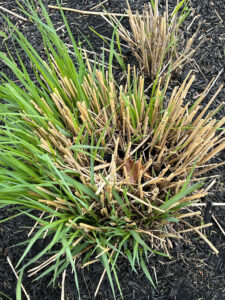
Ornamental grasses are a wonderful addition to almost any landscape. They offer year-round color, texture, and movement in the garden. They are versatile and so easy to grow.
Occasionally, however, they look like this when they come up in the spring. It is a sure sign that they need to be divided. Ornamental grasses usually need to be divided every 2-3 years, depending on their growth rate and the size of the clump.
Here are some other signs that indicate it’s time to divide your ornamental grass:
- Overcrowding: If the clump has become too large for its space, it can become overcrowded, which can lead to reduced growth and an unhealthy plant. This is a good indication that it’s time to divide.
- Reduced growth or flowering: If the grass isn’t growing as vigorously as it used to or has stopped flowering, it may be a sign that it needs more space to grow. Dividing the grass can help stimulate new growth and improve its overall health.
- Dead or brown patches: If there are dead or brown patches in the center of the clump, it can be a sign that the grass is no longer able to get the nutrients it needs from the soil. Dividing and replanting can help rejuvenate the grass and promote healthier growth.
- Unhealthy appearance: If the grass looks generally unhealthy, with yellowing leaves or stunted growth, it may be a sign that it needs to be divided. Dividing the grass can help promote better air circulation and allow more light to reach the center of the plant, which can improve its overall health.
In general, if you notice any of these signs, it’s a good idea to divide your ornamental grass to keep it healthy and looking its best.
Dividing ornamental grasses is a simple process that can be done in a few easy steps:
- Timing: The best time to divide ornamental grasses is in early spring before new growth appears or in fall before the first frost.
- Preparation: Dig around the entire clump of grass with a spade, leaving as much soil intact around the roots as possible. Use a sharp spade or garden fork to gently pry the clump out of the ground.
- Dividing: Once the clump is out of the ground, shake off any excess soil and then divide the clump into smaller sections. Use a sharp knife or garden shears to cut through the roots, making sure that each section has a good amount of roots attached.
- Replanting: Replant the divided sections immediately, spacing them apart according to the size of the grass. Dig a hole for each section and plant it at the same depth as it was previously growing. Water thoroughly and keep the soil moist until the grass establishes itself.
- Maintenance: Ornamental grasses are low-maintenance plants, but they benefit from occasional watering during dry spells and a light application of fertilizer in the spring. Cut back the foliage in the fall to prepare for winter.
Given just a little care, ornamental grasses will offer years of enjoyment.
